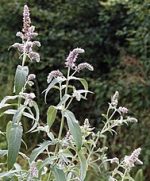 Also called wild mint, this herbaceous perennial is native to moist and wet habitats of Europe, western and central Asia, and southern and northern parts of Africa. Plants rapidly grow with a creeping rhizome to form colonies and have erect creeping stems that are square in cross section and 16-47″ tall. The strongly aromatic leave are stalkless, 2-4″ long, and oblong-elliptical to lanceolae. They are green to grayish green on top with white undersides and have sparsely toothed edges. In mid to late summer terminal spikes of small white to lilac or purple flowers appear. The spikes are branched, dense, and tapered. There are several mints that could be the one/s mention in the Bible but M. longifolia is the most likely. In ancient times mints of various kinds were used in cooking and in medicines and Jews scattered mint on the floors of their synagogues for the fragrance that arose as people stepped on it. As seen in the two verses below, mint was also an herb that was tithed by the Jews.
Also called wild mint, this herbaceous perennial is native to moist and wet habitats of Europe, western and central Asia, and southern and northern parts of Africa. Plants rapidly grow with a creeping rhizome to form colonies and have erect creeping stems that are square in cross section and 16-47″ tall. The strongly aromatic leave are stalkless, 2-4″ long, and oblong-elliptical to lanceolae. They are green to grayish green on top with white undersides and have sparsely toothed edges. In mid to late summer terminal spikes of small white to lilac or purple flowers appear. The spikes are branched, dense, and tapered. There are several mints that could be the one/s mention in the Bible but M. longifolia is the most likely. In ancient times mints of various kinds were used in cooking and in medicines and Jews scattered mint on the floors of their synagogues for the fragrance that arose as people stepped on it. As seen in the two verses below, mint was also an herb that was tithed by the Jews.
The passage is part of an address by Jesus to the crowd and his disciples. He is using the tithing of three herbs by the religious leaders as an example of how they are observing the rules about little things while ignoring the important matters.
Mathew 23.23 (NIV)
“Woe to you, teachers of the law and Pharisees, you hypocrites! You give a tenth of your spices—mint, dill and cumin. But you have neglected the more important matters of the law—justice, mercy and faithfulness. You should have practiced the latter, without neglecting the former.”
Luke 11.42 (NIV)
“Woe to you Pharisees, because you give God a tenth of your mint, rue and all other kinds of garden herbs, but you neglect justice and the love of God. You should have practiced the latter without leaving the former undone.”
Horsemint likes full sun to partial shade and average, moist soil in USDA Hardiness zones 6-9. It is suscetible to caterpillars, froghoppers, mint beetle, powdery mildew, and mint rust, and is rambunctious so proably needs restriction. Propagation is by cuttings and division.
Mint is a member of the deadnettle family, Laminaceae, that also includes basil, sage, and beebalm. The genus name, Mentha, comes from the ancient Greek word μίνθη that honors Minthe, a nymph who was transformed into a mint plant. The specific epithet, longifolia, comes from the ancient Latin words longum meaning long and folium meaning leaf.